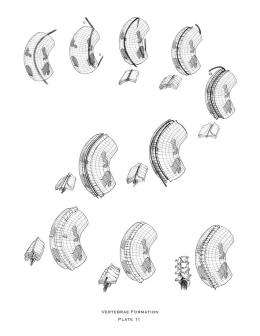Innovative solution to the evolution of form proposed

A new paper published in the International Journal of Astrobiology is providing a unique account of the origin of forms in plant and animal body plans. The model is not based on genetic code or natural selection, and could provide new insights into the origin and evolution of life on our planet.
The International Journal of Astrobiology has published "The Origin of the Vertebrate Skeleton," submitted by Synthetic Life Lab of New York City. The paper describes the hypothetical construction of a toroidal bilayer patterned with rows and columns representing molecular elements. The model is depicted in sequential animations to produce the general configuration of the human skeleton and the shapes of the component bones, the result of ten years of research in the quest for a mechanistic, geometric account of the origin of the forms of the plant and animal body plan.
Synthetic Life Lab, under the direction of Stuart Pivar, began its investigation with the study of the known configuration of the cell membrane as a phospholipid bilayer. Experimental models fabricated of PVC film led to hypothetical constructions based on configurations predicted by the inwardly directed expansion of a bilayer surface constrained within an outer fixed spherical envelope. The paper describes the steps leading to a toroidal bilayer, mimicking the vertebrate egg. The rotation of the interior surface of the bilayer with respect to the outer surface produced a model of the generation of the archetypal vertebrate skeleton, including the subsurface implantation of one or two chords, in mimicry of the notochord and nerve chord. Cortical rotation, the first stage after fertilization in observed embryology, is consistent with this theoretical model.
How life originated and evolved is arguably the greatest unsolved problem facing science. Thousands of scientists and scores of organizations and scientific journals are dedicated to discovering the mechanisms underlying this mystery. In the peer-reviewed journal’s letter of acceptance the reviewer states, " . . . the article should be published, so that as many scientists as possible can participate in the discussion on this new important subject.” Simon Mitton, prominent Cambridge scientist and IJA editor-in-chief, calls it “a groundbreaking concept.”
Mt. Holyoke paleontologist Mark McMenamin has called the discovery “a seismic event in science.” The model is based neither on a genetic code nor on natural selection, thus contradicting the orthodox Synthetic paradigm that has dominated evolutionary biology for seven decades. Nevertheless, this model offers an alternative naturalistic theory that can account for the origin of form without recourse to any form of creationism or supernatural intervention. If it should gain widespread acceptance, this model would negate the creationist argument that science has no theory for the origin of complex life.
More information: journals.cambridge.org/repo_A787SZ4p
Provided by Astrobio.net


















